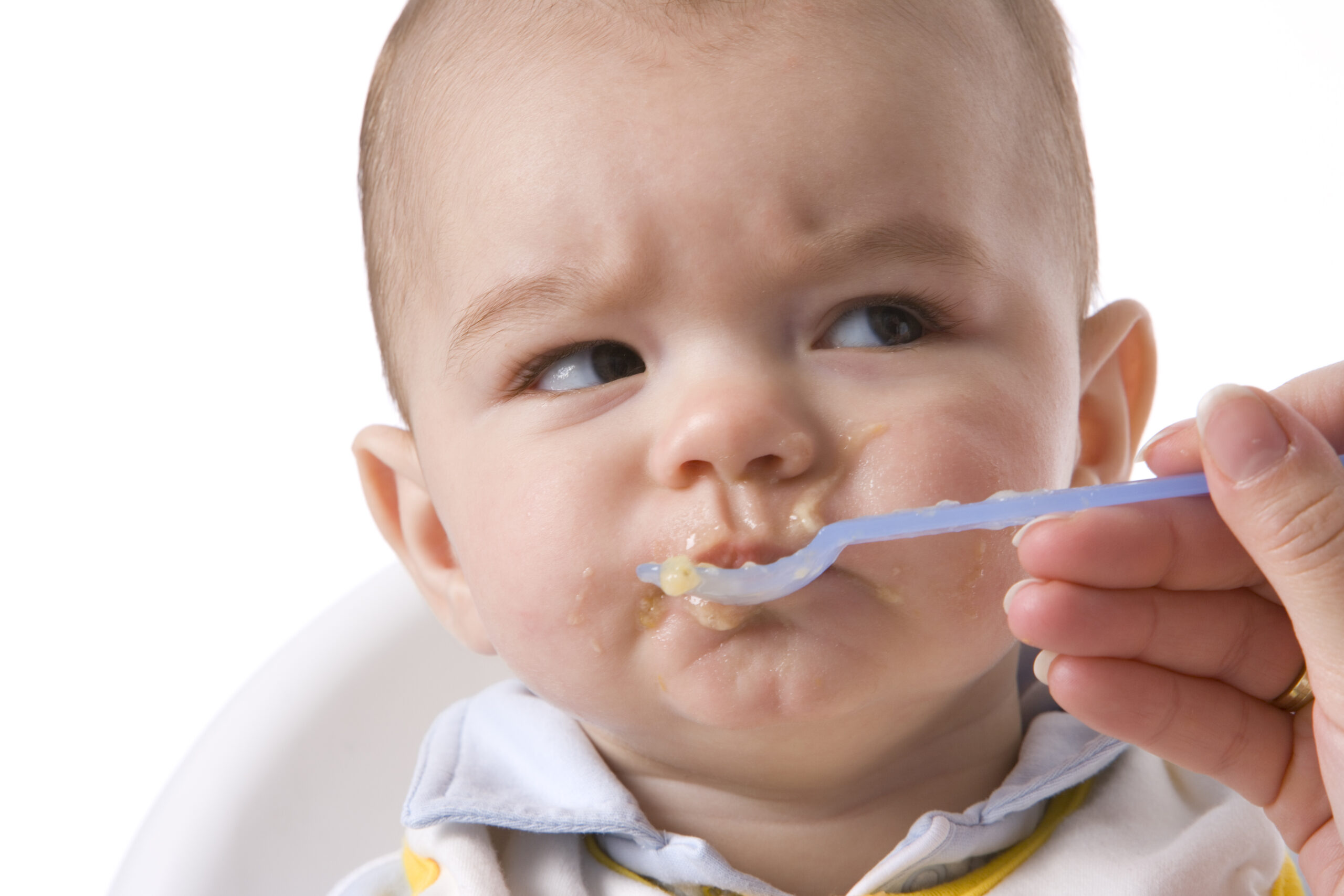I recently had a patient who choked on a piece of taco. She’s fine from the taco-incident. More concerning is that she was 2 months old. Yup, somebody actually gave their 2 month-old a taco ON PURPOSE. I still don’t know why. But if you’re wondering when to start your infant on solid foods and you’ve been reading the Internet to find the answer – I’m sure you are confused too. Websites are filled with conflicting information, particularly regarding the impact that starting foods has on a child’s risk of allergies and obesity. But at least you’ve got more sense than the taco-mom. So, honestly, you’re already off to a good start.
When should I introduce solid foods?
Various sources, including your pediatrician, will tell you to introduce solids at 4 months, some say 6 months and others say wait until after 6 months. Forget about the specific age. The best advice about when to start solids is sometime between 4 and 6 months. The baby’s exact age is not as important as their signs of developmental readiness. Researchers have examined the effect of introducing solids at different ages on factors like obesity, food allergy, and a variety of diseases (diabetes, celiac, eczema etc.) and the recommendations have swung in all directions.
What we know for sure is that babies’ kidneys can’t handle anything more than the balanced nutrition in either breast milk or formula until they are about 4 months old. And if you introduce food after 6 months of age, babies sometimes have a difficult time transitioning to a real food diet. Babies tend to be more difficult to wean from the nipple (breast or bottle) if food is introduced too late.
Baby is ready to eat food if he/she:
- sits with support and has good head/neck control. (will also be able to lift their head and chest off the ground when they are lying on their belly).
- has lost the “extrusion reflex” so that when you put something between the lips, they no longer automatically push it out with their tongue. Some babies have this reflex until they are 5-6 months of age.
- indicates a desire for food (leans forward and opens mouth) and is able to refuse food (turns head away or closes mouth).
Will I make my baby fat? …give her allergies? …increase infections?
Babies who are formula-fed and start solids before 4 months of age are more likely to be obese adults. But this doesn’t mean formula and early feeding cause obesity. These are characteristics of families with obese children.1,2 The media, and parents, interpret these research studies to mean that formula and early feeding somehow programs a child’s metabolism in a way that predisposes them to obesity. But this does not appear to be the case. Other factors have a far bigger impact on a child’s weight.
Research shows that parents’ own attitudes toward food, parental BMI (body mass index), as well as weight gain during pregnancy have far more influence and these factors accounted for the increased rate of obesity seen in babies who started solids before 4 months (or 6 months in some studies).1 If you think your infant is ready to start solids, and you are worried that you will predispose her to obesity, stop worrying about that. Put your mental energy into understanding her caloric needs and make sure you aren’t overfeeding. Watch closely for signs that your baby is full, and don’t give more than about 32 ounces of formula/breast milk each day. (Ask your pediatrician for a recommendation about how much milk is appropriate for your baby.)
Are you also concerned that introducing solid foods could cause your baby to have allergies? Early studies suggested that early introduction of allergenic foods increased allergic diseases (like asthma, food allergy and eczema) but better evidence available today suggests the opposite. A huge study of allergens in babies’ diets showed that giving fish, eggs, and certain cereals will not cause allergic diseases and may even prevent them if started between 4 and 6 months.4 More studies are still being done.
The one well-established association with feeding practices is that breast milk protects against respiratory and gastrointestinal (GI) infections.3 A review of 23 studies compared exclusive breastfeeding for 6 months against exclusive breastfeeding for 3-4 months, followed by a mix of formula and breast milk. The babies who were exclusively breast fed for 6 months had fewer GI infections, but the two groups were the same in terms of obesity, allergies and cognitive and behavior problems.5 So, breastfeeding exclusively until 6 months with no solid food consumption does appear to have better protection against GI infections.
What to feed
There are plenty of sources to give you advice about this. The AAP (American Academy of Pediatrics) recommends starting with cereals, then pureed meats. That’s a pretty good idea. But you aren’t doing any harm by starting with veggies or even fruits. Don’t worry about this so much. Pureed meats are recommended because they provide iron and zinc and baby is ready to start building stores of those minerals. In addition to following the widely known recommendations such as starting with single ingredient foods, here’s what I would focus on:
- Offer fruits and vegetables at least once a day from age 8-12 months. A great study demonstrated that this practice is highly correlated with fruit and veggie consumption at 6 years of age. When eating fruits and vegetables is part of daily life from as early as you can remember, that habit sticks for life. Wouldn’t you love to have a child who would think it was strange NOT to eat fruit or veggies as their snack?
- Read labels and avoid anything with added sugar or salt. These don’t make foods more palatable for babies. And adding these ingredients early will just set a lower threshold for sweet and salty tastes later in life.
- Fruit juice is fine, I’m not a big fan of it, but if you do provide juice limit it to 4-6 ounces per day, only give juice from a cup, not a bottle and only give 100% juice. Juice should only be given as part of a meal, not sipped throughout the day or given at bedtime.
- Know when to stop feeding: Recognizing the feeling of being full (satiety) is just as an important a feeding skill as anything else. How much should you feed? The baby will give you signs – watch for indications like the baby leaning back or turning away.
- Let babies play with their food. Kids learn the words for non-solids (pudding, applesauce, paint) more quickly when they actually squish them around!
When the voice in your head is debating about feeding your child the “right” food, just keep the overall goal in mind and be sensible in terms of when to start and what to feed. The goal is to introduce a variety of foods, tastes and textures by the end of the first year so they can transition to a mostly food diet by 12 months and to create a healthy attitude towards food.
References
- Early life course risk factors for childhood obesity: the IDEFICS case-control study. PLoS One. Bammann K et al. 2014 Feb 13;9(2):e86914.
- Timing of solid food introduction and risk of obesity in preschool-aged children. Pediatrics. Huh SY et al. 2011 Mar;127(3):e544-51.
- Prolonged and exclusive breastfeeding reduces the risk of infectious diseases in infancy. Duijts L, Jaddoe VW, Hofman A, Moll HA. Pediatrics. 2010;126(1).
- Timing of infant feeding in relation to childhood asthma and allergic diseases. Journal of Allergy and Clinical Immunology. Bright I. Nwaru, et al. Volume 131, Issue 1, Pages 78–86, January 2013.
- Optimal duration of exclusive breastfeeding. Cochrane Database of Systematic Reviews. Kramer MS, Kakuma R. 2012, Issue 8.






